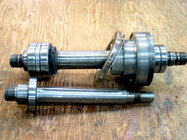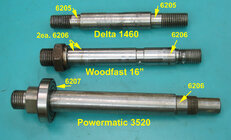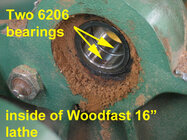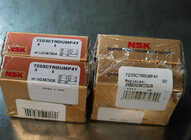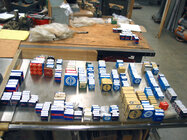- The Powermatic 3520(a,b,c) is very popular. But I wonder, is that just legacy or is it justified today when compared to other manufacturers? Is the Powermatic better than the Jet, Laguna, or Rikon of the same size?
- Taking that same question to the next level, are the Robust and OneWay lathes that much better than, say, the Powermatic? Put another way, are the top end lathes really $3-4,000 BETTER than the Powermatic, et al?
I've been through a few lathes since I started, and also used a couple others at the local woodcraft a good bit.
First, I would agree, 18-20" would be classified as a full-sized lathe.
I started with a Nova midi sized lathe. It was the Comet 14DR a 14x20" IIRC, in Feb 2020. It worked ok for about 5 months, then started to have problems. Teknatool in Florida sent out a replacement control box, which didn't fix the problem. Then they sent out THREE MORE after that, insisting the problem was in the control box and not elsewhere. In late September I finally managed to get them to RMA the thing, and they had it until the end of January the next year. In the end, they ended up rebuilding most of it, and the problem was in the motor and headstock...if I recall correctly here. Took another month to get the thing back, and it had a LOUD scraping sound in the headstock. I haven't really used it since. I've used some other Nova lathes, including that was more of a full sized 18" lathe, the "DVR" type. I would say, the DVR line of Nova lathes are pretty nice and I do like the DIRECT DRIVE concept, but in general I don't care too much for Nova. In all honesty, I don't think I can exactly put my finger on what it is about them, but, they just don't quite seem to measure up when I compare to Jet & Powermatic (or say Robust).
I've used one Rikon midi sized lathe. It seemed a bit more solidly built than the Nova Comet 14DR, and seemed a bit quieter. Quiet is a big factor for me, and not all lathes are equal here! Can't say a lot about Rikon, the only tools of theirs that I own are my grinder, which I slapped some CBN wheels on and I think it does a fine job, and my belt sander, which was a NOISY beast until I discovered that there was an access panel on the back (way over-tightened at the factory, hence it took me a while to realize it WAS supposed to be accessible) and was able to tighten the drive belt. Since then its become quieter, but, I would put it in generally the same class as Nova. Ok, not great, could be better. Good way to start, but if you are really going to put some heavy use onto a machine, I think there are better options.
While I was waiting for Teknatool to fix my original Nova lathe, late in 2020 I purchased a Wen 14x20" midi lathe. To my surprise, this little lathe, which I still own and still use, has been an amazingly sturdy, generally well crafted workhorse lathe. I do most of my pens on this lathe, I do most of my other small turnings on this lathe, and it has helped me make a LOT of items over the years. I've had it since, IIRC, November 2020. Its actually my most used lathe overall. Wen customer support is the easiest to work with by far, and they never make it troublesome if I need a part or anything like that (Due to an incorrect manufacturing spec with the MT2 mandrel for the Beall 3-wheel buffing system, which was NOT actually manufactured to the correct MT2 specced angle, it damaged the inside of my Wen lathe spindle. Lee Valley, who bought the rights to this product when Beall closed their doors, graciously listened to my explanation of the problem and fixed it, and sent me some money to compensate for the damaged part.) I did have to buy the replacement spindle as it was out of warranty, but in general I've never had any problems working with Wen technical support (which is in stark contrast to Teknatool, where I can't even begin to describe the strange, often wildly strange, experiences I've had with their tech support.) I would NOT put Wen in a high grade class like Robust or OneWay. They are generally the same quality as Nova, Rikon, etc. I know that people have certainly had issues with them as well, and there is plenty of commentary about QC variability. So my experiences may just be luck of the draw. As you mentioned as well, a midi lathe only takes you so far!
During the many months of time I was waiting for my Nova lathe to be repaired and returned, I wanted to get into turning larger items. A 14" lathe can only handle wood pieces so large, so I ended up purchasing a Laguna Revo 1524 with Precise Point. I was really excited about getting a larger-sized lathe, and the Revo, out of all the lathes I have used, is very, very quiet!! I LOVED how quiet it was. I think its one of the quietest lathes around. I honestly don't know if the 1524 can be called a full-sized lathe...its certainly not as big as my main lathe that I have now (more in a bit) nor anywhere as big as a Robust or OneWay full sized lathe. But its definitely bigger than a normal midi sized lathe. I turned a few vases, medium sized (I'd say up to about 8" spindle size), on the Laguna, along with a few platters up to 14" in diameter, among other smaller bowls (6-8"). Sadly, my experiences with Laguna ended up not being so great. This lathe, too, to my great dismay, experienced some problems. The initial problem I ran into was the tailstock design...Laguna's Precise Point, IMHO, is a disaster. There is only about a 1" thick block of metal attached to the end of the tailstock that actually holds the quill in the tailstock...that's it. The rest of the tailstock is a square shaped hollow on the inside, which is required to allow the "precise pointing" capability (you can loosen this block of metal, and move it around a little bit to adjust the pointing of the quill to your dead center in the headstock), and then a loosely fit worm that attaches to the crank to drive the quill in and out. The first problem I ran into, which I first noticed pretty early on, but didn't really realize what was causing it until early summer, was that the quill, particularly when extended about half way or more (which was often necessary with platters due to the thick banjo), was too poorly supported and wobbled around. It did NOT provide truly stable support and would, unless I spent too much time trying to manually center the live center, "orbit" around the true dead center of rotation and cause problems turning. The orbit could be as much as several millimeters off center, which is quite significant. I started working with Laguna to fix this, which in the end only included them sending me a thin (maybe 1mm thick) metal clip that had a prong on it, that was bolted to the ~1" thick block of metal that was all that held the quill stable. This clip was supposed to be pushed into the groove on the side of the quill, and the little prong was supposedly capable of stabilizing it (it was not!) I struggled a lot with the lathe throughout the summer, and had little success (the issue seemed to get worse over time, I suspect as I used it, the small block of metal that actually held the quill probably faced some wear and the bore in it probably enlarged a bit.) By fall 2021, the lathe suddenly exhibited a problem where it could no longer maintain power under load. I'd hardly been using it, due to the tailstock problems. Spindle only and it would spin roughly at the right RPM, but there were dropouts and dips. Even a small load, though, such as putting on my longworth chuck, resulted in severe and repetitive RPM (and thus power) dropouts. The lathe couldn't handle turning at all, once a tool was applied to a wood blank the lathe couldn't handle it. Several months later, after having replaced the entire tailstock once, the motor once, and then ultimately the entire headstock, the lathe was working again by January 2022... However the tailstock issues persisted...and Laguna ghosted me. I received no further support from them, no communications of any kind. I finally gave up on the lathe and eventually sold it, as the tailstock/quill issue was a consistent problem, particularly with platters and vases, both if which at least in my experience need pretty stable support from the tailstock when doing the primary shaping.
PART 2 ->

